Manuscript accepted on : 15 September 2017
Published online on: --
Plagiarism Check: Yes
Low Cost Multiplication of Curculigo Orchioides in Shake Flask Culture
Sudha Sahay and Vincent J. Braganza
Loyola Centre for Research and Development, Xavier Research Foundation, Navrangpura, Ahmedabad – 380009, Gujarat, India.
Corresponding Author E-mail: Sudha.sahay@xrf.res.in
DOI : http://dx.doi.org/10.13005/bbra/2546
ABSTRACT: Low cost multiplication of Curculigo orchioides on a large scale was done through direct bulbil formation from leaf explants in shake flask cultures. The leaf segments (1 cm long) were cultured in liquid MS medium without any growth hormones supplement. About 95% explants produced bulbils at an average of 5 bulbils per leaf segment in a 6 weeks incubation period. Total yield of bulbils was 250 bulbils per litre of liquid MS medium. During the incubation period, darkening of the media was observed from the 3rd week of inoculation of the leaf segments. This was due to the excretion of phenolic compounds from the cut-ends of the leaf segments. When darkening was highly intense (dark brown to black), it inhibited the further growth of bulbils. Therefore, once in six weeks, the liquid media was changed to ensure continuous growth of bulbils. Germination of bulbils was 100% on MS agar-medium (static medium) when supplemented with BAP: Kn: NAA (1.0:0.1:1.0 mg/l) growth hormones. Tuberous root segments also proliferated into dense roots when inoculated into the liquid MS medium, without any growth hormones.
KEYWORDS: Bulbils; Curculigo Orchioides;Tuberous Roots; Rhizome
Download this article as:| Copy the following to cite this article: Sahay S, Braganza V. J. Low Cost Multiplication of Curculigo Orchioides in Shake Flask Culture. Biosci Biotech Res Asia 2017;14(3). |
| Copy the following to cite this URL: Sahay S, Braganza V. J. Low Cost Multiplication of Curculigo Orchioides in Shake Flask Culture. Biosci Biotech Res Asia 2017;14(3). Available from: https://www.biotech-asia.org/?p=27607 |
Introduction
C. orchioides Gaertn. (family – Hypoxidaceae) in Hindi called “Kali musli” is a Monocot, perennial, stem-less herb with tuberous roots. The plant is a native of India and has medicinal importance. Tuberous roots of C. orchioides are widely used as tonic for health, vigour and vitality due to the presence of flavanone glycosides. The plant is naturally propagated through seeds and underground bulbils. However, seed set and germination is poor. Most of these plants are collected from the wild, very often in a destructive and unsustainable manner. Tubers of the plant obtained from the forests provide seasonal income to tribals during the monsoon in north and south Gujarat. “Kali musli” is documented to be an endangered species due to over-exploitation (Augustine and D’souza, 1998). The Department of Biotechnology, Ministry of Science and Technology, New Delhi has also included it in the list of endangered plants (Anonymous, 2000). The gradual decline in the population of this species demands conservation efforts to ensure continuous and ample supply of this valuable material which is in great demand in the local user market as well as by the pharmaceutical industry. The approach needs to be to establish a balanced cycle of harvest and renewal. Efforts are needed to propagate this species on a commercial scale to meet the demand of pharmaceutical industry and to protect the existing natural population of the species. Keeping the above facts in mind, the present study was undertaken to develop a suitable protocol for its rapid multiplication at a low cost.
Earlier, we have reported shoot and root proliferation from leaf and root explants in C. orchioides by using different compositions and combinations of growth hormones (Sahay and Braganza, 2015). Excised leaf and root explants from in vitro plantlets served as an aseptic reservoir of inoculum for large-scale multiplication of plantlets and roots in shake flask cultures. Direct regeneration of bulbils and roots from the leaf and root explants respectively makes them an excellent system for such a purpose. Bulbil formation has gained considerable attention as a novel method for micropropagation due to ease in transportation, better survivability of germinated bulbils in soil, low cost, and rapid propagation. In this communication, we report a low cost method for large scale propagation of C. orchioides through direct bulbil and root formation in shake flask cultures.
Materials and Methods
Bulbil Formation from Leaf Segments
Young leaves of C. orchioides from aseptically maintained plantlets were used as a source material. Leaf segments (~ 1 cm long) were aseptically transferred to liquid MS (Murashige and Skoog, 1962) medium without any growth supplement. 100 ml liquid medium was taken in 250 ml Erlenmeyer flasks. A total of 5 leaf segments were transferred to 20 flasks and three such replicate cultures were used each time. The cultures were incubated at 25 ± 2 °C under white fluorescent light (Philips cool TL 36W/54, 220 volts) with a total irradiance of 36 J-mol m-2 S-1 for 16 hr photoperiod and 70 % relative humidity. The cultures were agitated on a rotary shaker at 90 rpm with 5 cm displacement from the central axis.
The colour of the medium underwent change from white transparent to brown during the second week and to dark brown or black by the end of the third week after inoculation due to the secretion of phenolic compounds from the cut-edges of the leaf segments. The darkened medium was replaced with fresh medium once in 3 weeks to eliminate the leached dark brown substances. During the fifth week of inoculation, the leaf margins were heavily curled forming loop like structures. Each loop produced a bulbil.
Plantlet Development from Bulbils
Bulbils obtained from shake flask cultures were transferred to static MS medium containing BAP (1.0 mg/L), Kn (0.1 mg/L) and NAA (1.0 mg/L). The hormonal composition and concentration in the static medium was earlier shown to be effective for C. orchioides shoot proliferation (Sahay and Braganza, 2015). This medium was gelled with 0.8% (w/v) bacteriological agar (Hi-Media). 80 mL of the medium was poured into culture bottles (250 ml) and 20 mL of the medium was poured into culture tubes (100 ml) prior to autoclaving it .Within 30 days of transfer, all bulbils grew as healthy plantlets. These plantlets were exposed to primary and secondary hardenings followed by transfer to the field where the plantlets were grown under natural conditions.
Primary and Secondary Hardening
Plantlets developed in vitro through germinated bulbils were washed with a systemic fungicide, carbendazim (2-methoxy carbamoyl)-benzimidazole (1 %, w/v) for 5 min and planted in plastic pots (150 mL) containing sterilized garden soil:manure (1:1) mixture for primary hardening. To maintain high ambient humidity (70-80 %), pots were covered with transparent polythene bags having a few pores to allow gaseous exchange. Plants were irrigated as and when required (25 mL/pot), with sterile RO (Reverse Osmosis) water. All pots were kept at 25 ± 2°C under white fluorescent light (Philips cool TL 36W/54, 220 volts) with a total irradiance of 36 J-mol m-2 S-1 for 16 hr photoperiod. After 15 days, primary hardening was followed by secondary hardening which lasted to another 15 days. During secondary hardening all polythene bags were removed and the plants were exposed to sunlight 2 hr/day and for rest of the period, plants were kept in moisture and a shaded place in the green house. One month old plantlets were finally transferred to the field and exposed to the external environment.
Root regeneration from Tuberous Roots
Root regeneration was done in liquid MS media without using any growth supplements. The tuberous roots of C. orchioides collected from the green house of our Institute were used as a source material. The tuberous root segments were surface sterilized by using the method reported earlier in our laboratory (Sahay and Braganza, 2015). Surface sterilized tuberous root segments were cut into small discs under aseptic condition. Each root disc was ~0.5 cm in diameter and ~1 mm thickness. 5 root discs were inoculated into 100 ml sterile liquid MS medium in 250 ml Erlenmeyer flasks. The incubation conditions were the same as in the case of bulbil formation in shake flask cultures. Similar to the leaf cultures in shake flasks, the root culture medium also changed colour from transparent to black in 3 weeks of incubation. Hence, the darkened medium was replaced with fresh medium. Observations were made upto 8 weeks of inoculation, until a dense mass of elongated white roots appeared on the root discs.
Results and Discussion
Young leaf segments (~1 cm long) of proliferated shoots transferred into liquid MS medium without any growth supplement produced a varied number of bulbils without intervening callus (Fig. 1). Bulbils were initiated after 3 weeks of inoculation in 250 mL Erlenmeyer flasks, having 100 mL liquid MS medium inoculated with 5 leaf segments. Each segment produced an average of 5 bulbils. Thus 100 mL media produced on an average 25 healthy bulbils. The rate of bulbil production was 250 bulbils per litre of liquid MS medium. The bulbils developed in vitro were brown with a brown-black crust and a dormant shoot apex (Fig. 2). All bulbils with distinct radical and plumule when separated and transferred on static MS medium supplemented with BAP:Kn:NAA (1.0:0.1:1.0 mg/l), germinated into healthy plantlets (Fig 3a,b,c,d). The rate of germination of bulbils was found to be 90% on static medium. The un-germinated bulbils varied in their weight, either ≥30 mg or ≤100 mg. About 30 % of the un-germinated bulbils weighing upto 10 mg.
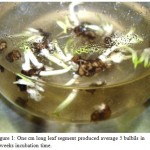 |
Figure 1: One cm long leaf segment produced average 5 bulbils in 6 weeks incubation time.
|
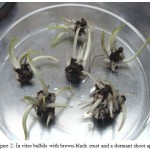 |
Figure 2: In vitro bulbils with brown-black crust and a dormant shoot apex.
|
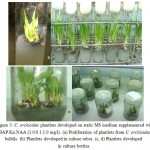 |
Figure 3: C. orchioides plantlets developed on static MS medium supplemented with BAP:Kn:NAA (1.0:0.1:1.0 mg/l). (a) Proliferation of plantlets from C. orchioides bulbils. (b) Plantlets developed in culture tubes. (c, d) Plantlets developed in culture bottles.
|
Shake flask cultures produced 250 bulbils per litre (from 50 leaf segments) medium in six weeks. By the end of the sixth week, each bulbil formed a distinct radicle and plumule. Bulbils produced in vitro weighed 20-150 mg (fresh weight). All these 250 bulbils transferred to static medium supplemented with growth hormones to develop a plantlet. However, only 225 bulbils were germinated into healthy plantlets in 2 weeks. The 25 un-germinated bulbils were died on the static medium due to their under or over weight. The yield perhaps can be increased further by manipulating the size and numbers of the leaf segments. Though, in this experiment the number of bulbils per segment remained lower in the liquid medium, the over-all yield per litre of medium can significantly increase with increase in number of leaf segments. A high percentage of germination was observed in the bulbils weighing 40-90 mg. It is presumed that the small sized bulbils (≥30 mg) were not fully matured while the over-sized (≤100 mg) bulbils had developed a certain level of dormancy. The bulbils that grew as healthy plantlets and attained upto 5 to 6 cm height in static medium were subjected to primary and secondary hardening (Fig. 4a,b). An average of 75% plantlets survived during the primary and secondary hardening and a further 80 % rate of survival was observed under field conditions.
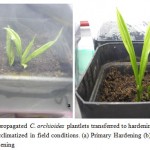 |
Figure 4: Micropropagated C. orchioides plantlets transferred to hardening process to make them acclimatized in field conditions. (a) Primary Hardening (b) Secondary Hardening
|
Earlier, many researchers have used different broth and static media such as MS and B5 supplemented with various compositions and concentrations of growth hormones for the development of C. orchioides bulbils. Suri and Arora (1998) and Suri and Jain (1999) regenerated in vitro plantlets and achieved bulbil formation from leaf and stem explants of C. orchioides on B5 media supplemented with 4.4 μM BAP. Stem-disc-derived callus produced numerous bulbils on media containing BAP (8.8–35.2 μM) and sucrose (0.12–0.23 M). Maximum number of bulbils (10 bulbils per explant, 0.19 g fresh weight per bulbil) were recorded on the medium supplemented with 35.2 μM BAP and 0.18 M sucrose. Suri and Arora (2000) multiplied C. orchioides through bulbil formation from leaf explant in shake flask cultures. They have used B5 liquid medium supplemented with BA and GA3 and their yield was 2737 bulbils/L whereas static cultures produced 625 bulbils/L. Nema et al (2008) reported that morphactin and cytokinin promote high frequency bulbil formation from leaf explants of C. orchioides grown in shake flask cultures. They used growth hormones viz. BA and IBA added to the liquid MS medium which resulted in bulbil formation in 8 weeks of incubation. About 1 cm2 leaf explant was used per 2 mL liquid medium (50 explants 100 mL-1) and was shown to produce 1027 g (fresh weight) bulbils.
Similar to the bulbil formation from the leaf segments, the root regeneration from the tuberous root discs was also observed in the liquid MS media without using any growth supplements. The tuberous root discs of ~0.5 cm in diameter and ~1 mm thickness produced many white long roots all over the disc surface (Fig. 5a,b) The incubation conditions were same as in the case of bulbil formation in shake flask cultures. Observations were made upto 4 weeks of inoculation, until the dense mass of elongated white roots which appeared on the root discs turned dark brown (Fig. 5b, c). Earlier, the blackening of the C. orchioides was observed by various researchers during micropropagation (Parameswari et al, 2013; Sahay and Braganza, 2015). It has been stated that colour change from white to brown was due to the deposition of extra cellular phenolic compounds secreted from the root cells,
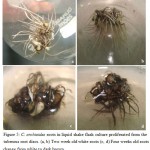 |
Figure 5: C. orchioides roots in liquid shake flask culture proliferated from the tuberous root discs. (a, b) Two week old white roots (c, d) Four weeks old roots change from white to dark brown.
|
Various scientists have worked on the micropropagation of C. orchioides Gaertn, and have obtained closely related results (Suri and Arora, 1998; Dhenuka et al, 1999; Suri and Jain, 1999; Suri and Arora, 2000; Prajapati et al, 2003). However, this work is the first to report bulbils and roots formation in synthetic medium devoid of growth hormones within 6 weeks of inoculation which cuts down the heavy cost of using hormones.
Conclusion
A method has been developed for rapid multiplication of C. orchioides through direct organogenesis and bulbil formation in vitro. Aseptically proliferated leaves and field growing plant roots were used as source material. Leaf segments devoid of intermediate callus formation, directly produced numerous bulbils in basal liquid MS medium. A maximum number of bulbils (average 5 bulbils per leaf segment) with a varied range of fresh weight 20-150 mg of each bulbil were recorded. About 90% bulbils grew as healthy plantlets with an average weight of each plantlet upto 6 g (fresh weight) after 15 days of transfer to static medium. Further plantlets increased in weight upto 36 g (fresh weight) after 30 days of transfer to field conditions prior to primary and secondary hardening. Root proliferation was also observed from the tuberous root discs (25-30 roots/disc) when inoculated in the 100 mL liquid MS medium. Growth of in vitro produced bulbils into plantlets and rhizogenesis from tuberous root discs was achieved on static MS medium devoid of plant growth regulators. The plantlets developed in vitro were successfully transferred to the soil. The tuberous roots developed in vitro did not showed further growth while transferred to the soil. The micropropagated plantlets sprouted after post-monsoon i.e., during winter under natural conditions. Since, the C. orchioides tuberous root has lots of medicinal applications identified in Ayurveda, Unani medicine system and pharmaceutical industries; therefore, the present work is widely applicable at a commercial level.
Acknowledgement
We are thankfully acknowledging the support of Loyola Centre for Research and Development, Xavier Research Foundation to conduct the experiments.
Conflict of Interest
The authors have no conflict of interest.
References
- Anonymous (ed): Plant Tissue Culture from Research to Commercialization – A Decade of Support, Department of Biotechnology, New Delhi, India 2000;33-34.
- Augustine A. C., D’souza L. Regeneration of an anti-carcinogenic herb, Curculigo orchioides (Gaertn). In vitro Cell Dev. Biol. Plant. 1998;33:111-113.
CrossRef - Dhenuka S., Balakrishna P., Anand A. Indirect organogenesis from the leaf explants of medicinally important plant Curculigo orchioides J. Plant Biochem. and Biotech. 1999;8:113-115.
CrossRef - Murashige T., Skoog F. A revised medium for rapid growth and bioassays with tobacco tissue cultures. Plant. 1962;15:473-497.
- Nema R. K., Dass S., Mathur M., Ramawat K. G. Morphactin and cytokinin promote high frequency bulbil formation from leaf explants of Curculigo orchioides grow in shake flask culture. Indian J. of Biotechnology. 2008;7:520-525.
- Prajapati H. A., Patel D. H., Mehta S. R., Subramanium R. B. Direct in vitro regeneration of Curculigo orchioides, an endangered anti-carcinogenic herb. Current Science. 2003;84:747-749.
- Parameswari A., Rahul R. N., Thilaga S., Ganesh D. In vitro regeneration and root induction from Curculigo orchioides Gaertn – A high valued medicinal plant. J. Biological Technolog. 2013;4(2):1-1.
- S., Braganza V. Early rhizogenesis of Curculigo orchioides Gaertn. Plant Cell Biotechnology and Molecular Biology. 2015;16(1&2):93-98.
- Suri S. S., Jain S. Plantlet regeneration and bulbil formation in vitro from leaf and stem explants of Curculigo orchioides, an endangered medicinal plant. Scientia Horticulturae, 1999;79(1&2):127–134.
CrossRef - Suri S. S., Arora D. K. Rapid micropropagation through direct somatic embryogenesis and bulbil formation from leaf explants in Curculigo orchioides. J. of Exp. Biol. 1998;36(11):1130-1135.
- Suri S.S., Arora D. K. A method for large scale multiplication of Curculigo orchioides through bulbil formation from leaf explant in shake flask culture. J. Exp. Biol. 2000;38(2):145-148.

This work is licensed under a Creative Commons Attribution 4.0 International License.





